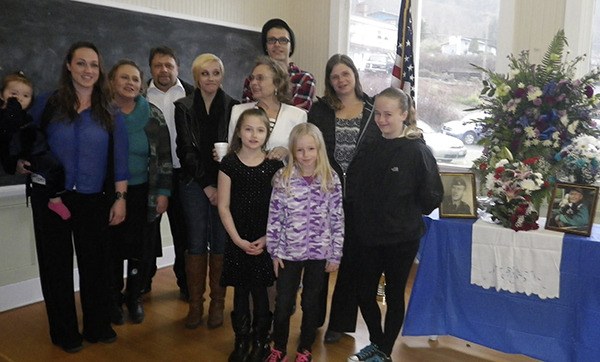A Presentation of Memory was held in memory of Arlen Alto Olson, in the Sekiu Community Center, Saturday, Jan. 17. The presentation included a poetry reading, photo slideshow with music and a potluck.
Grant Monroe opened the celebration by reading from Olson’s obituary. Olson was born June 19, 1933, and died on Dec. 31, 2014. He was 81, and died peacefully at his home of heart complications. He was surrounded by his family.
Olson played football in school. He went into the army in 1950, served in the Korean War, and was discharged in 1953. He learned to fly in Port Angeles and aerial acrobatics in Seattle.
Olson married Donalynn Bonney, from Port Angeles, on Oct. 25, 1958. They had three children, Julie, Valorie and Scott.
Monroe read that Olson loved duck-hunting, flying, weight-lifting, getting work done and all his four-legged friends. He always had Milk Bones in his truck for whatever dogs he might meet, including Monroe’s.
Olson’s granddaughter Tasha Dawley, with Laura Stikers, read a poem dedicated to Olson, written by Jackie Gonzalez, expressing the longing to see the man again. The poem celebrated a man who liked the little things like coffee, French bread and fried chicken, and the greater, like the lives of his family and the safety of his town, Sekiu.
Lines from the poem say it all:
“The headlights on the hill,
No longer burn bright.
And the watchman’s finally asleep.
Leaving behind a legacy,
Full of memories I get to keep.”
Granddaughter Cassie Burrow took the floor and said, “This is not a funeral but a celebration of an amazing life.” She thanked attending friends for the family, and — pointing out how food had been a big part of Olson life — invited everyone to the generous potluck downstairs, in the dining and meeting hall. She said that there was always time for other things, but:
“Sometimes you just eat the damn food.”
The slideshow was accompanied by music that included punk rock behind shots of an adventurous life, including football and in the military, Elvis for the wedding shots and — for pictures of the energetic Olson children — “Wild Thing.”
One shot, labeled as a crash, got a gasp and a laugh from the audience. It showed a lightweight plane shattered in a tree, recalling memories that Olson had not only loved flying, but had built the Sekiu airport in the 1960s.
No one seemed to recall any details of the crash, but Olson must have walked away from it, reflecting the old pilot proverb that “Any landing you walk away from is a good one.” Such crashes of lightweights and experimentals aren’t unusual or due to pilot error, more often being the result of the ease with which even slight winds can blow them out of control.
Ken Lisk remembered when his father Charles and Olson’s father Al started running boats from the beach next to each other in Sekiu, circa 1938-1939. They built the old breakwater together.
When Arlen took over the business from Al in the 1950s, he filled in the cove around the three outcroppings called “The Three Sisters,” which remain standing to this day in the Olson’s Resort parking lot. He also rebuilt the breakwater into its present-day configuration.
Lisk said, “Arlen and (Arlen’s brother) Gene and I were “The Three Musketeers.”
Lisk said the three of them grew up cleaning boats and cabins and taking care of the tourists for the resorts. Around 1967, Ken sold the Lisk Resort to Olson’s.
Tom Hahn remembered Olson’s part in the building of the Clallam Bay Correctional Facility in the 1980s. Barges of gravel from Canada were offloaded at the Olson’s Resort docks.
Arlen’s son Scott drove the dump-truck loads of gravel up the hill to the construction site for two years. Hahn, managing the tribal concrete company in Neah Bay, said the Makah had the concrete contract.
Working with Olson as a friend in the 1990s, Hahn installed the foundation on the two-story building on resort property and steel-encased the wooden pilings behind the resort breakwater.
According to Hahn, Makah tribe tribal fishing boats — 20-30 of them — originally off-loaded sockeye during the August fishing season at the resort docks. Natural shifting of gravel from Sekiu’s glacial till gradually made the harbor too shallow to take deep-draft commercial fishing boats.
Jerry Hoeppner, now living in Port Hadlock, said that his dad established Jack’s Place circa 1938. The store was then sold in the 1950s to Keith and Milly Olson, Arlen’s parents, before being sold to the present owner, who renamed it Ray’s Grocery.



